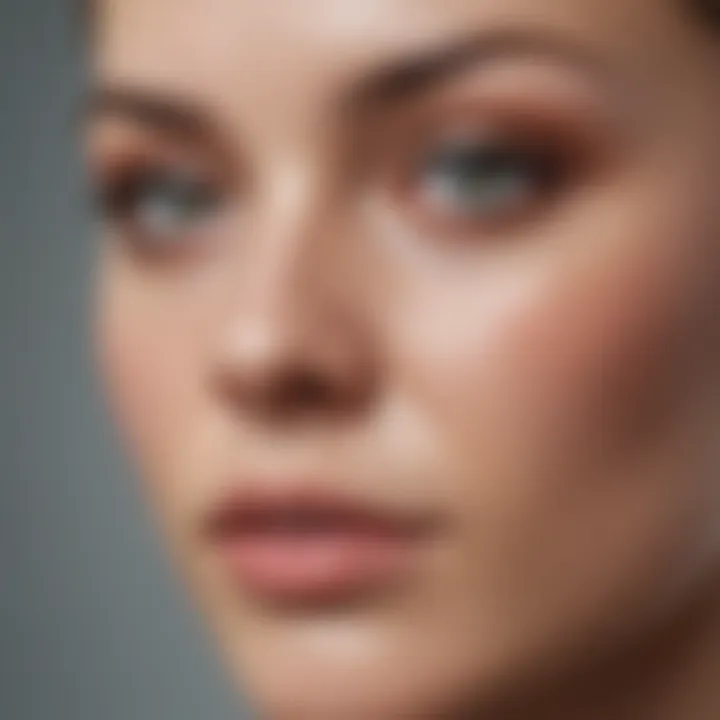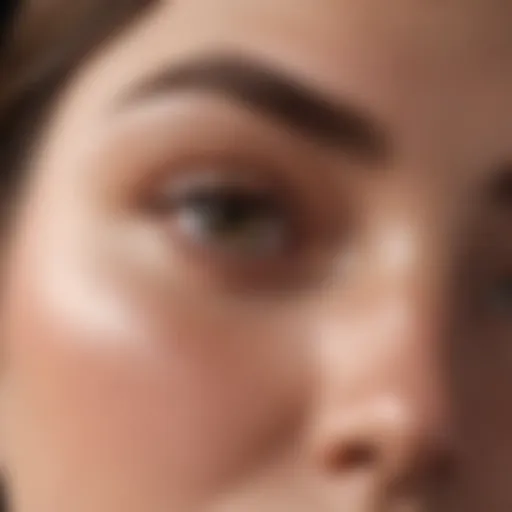Top Strategies for Effectively Removing Facial Zits


Intro
Navigating the world of skincare can feel like a maze, especially when it comes to dealing with zits on the face. With myriad products and treatments heralded as miracles, it’s easy to become overwhelmed. What works for one person might not work for another, making the quest for clear skin an often frustrating journey.
Acne isn’t just a teenage hurdle; it affects adults too, with stress, hormonal shifts, and environmental factors contributing to breakouts at any age. This article takes a closer look at effective strategies to manage and reduce acne, diving into proven treatments, lesser-known remedies, and crucial preventative measures that might just become your skincare secrets.
In our exploration, we aim to clear the smoke and mirrors around common misconceptions often found in the realm of acne advice. The goal is to arm readers with solid knowledge—from recognizing the signs of emerging zits to implementing practical daily routines that promote healthier skin.
Let’s step into this world together, where informed choices lead to clearer skin, fostering both confidence and well-being.
Skincare Regimens
Understanding your skin is fundamental in the battle against zits. Here are some key strategies to build or enhance your skincare routine:
- Cleansing: Use a gentle cleanser suited to your skin type twice daily. Opt for products with salicylic acid or benzoyl peroxide, which can help unclog pores and reduce inflammation.
- Exfoliating: Incorporate a mild exfoliant a few times a week. This removes dead skin cells and helps prevent clogged pores.
- Moisturizing: Even oily skin needs hydration. A lightweight, oil-free moisturizer can protect skin without adding to oiliness.
- Spot Treatments: Have a reliable spot treatment on hand for unexpected zits. Look for concentrated treatments containing ingredients like azelaic acid or tea tree oil.
"Prevention isn't just better; it's the only true cure for acne-related woes."
Treatment Options
When zits do erupt, knowing how to treat them effectively is essential. Here’s a list of commonly used treatments and their effectiveness:
- Topical Medications:
- Oral Medications:
- Professional Treatments:
- Retinoids: Help prevent clogged pores and can fade post-acne marks.
- Antibiotics: For treating inflammation and bacteria, prescribed for moderate to severe cases.
- Hormonal treatments: Such as birth control pills for women can regulate hormones and reduce breakouts.
- Isotretinoin: A powerful medication reserved for severe acne, with a range of side effects.
- Chemical peels: Help resurface the skin.
- Laser therapy: Can reduce bacteria and inflammation.
Each treatment carries its benefits and potential downsides, so it’s important to consult with a dermatologist to find the best course of action tailored to your skin.
Common Misconceptions
The realm of skincare is rife with myths that can mislead individuals in their quest for clearer skin. Here are several misconceptions to debunk:
- "Popping zits speeds up the healing process": In reality, it can lead to scarring and infection.
- "Chocolate and greasy foods cause acne": While diet can influence skin health, it’s not the sole culprit of acne.
- "Sunscreen makes acne worse": Today’s formulations offer solutions for oily and acne-prone skin, protecting without exacerbating issues.
Understanding these myths allows for more informed decisions in skincare practices.
Understanding Zits
Understanding zits goes beyond just seeing them on the skin; it cuts into the very nature of what these pesky skin irritations are, why they pop up, and what we can do to manage them better. This section serves as a foundation for grasping the intricate workings of acne. Knowing the biology, types, and general causes of zits lays down the groundwork for selecting the most effective strategies to tackle this common skin concern. Many individuals face emotional distress due to zits, making it even more essential to not just treat the symptoms but also comprehend the underlying causes. This understanding empowers readers to adopt informed skincare routines and lifestyle choices that can significantly reduce outbreaks.
What Are Zits?
At their core, zits are small bumps on the skin, often synonymous with acne. They can appear anywhere on the body but tend to congregate on the face due to higher concentrations of oil glands. Zits occur when hair follicles become clogged with dead skin cells, excess oil, and bacteria. This block not only leads to the characteristic swollen red appearance but can also result in tenderness and pain. The world of zits isn't one-size-fits-all; they can range from minor annoyances to severe outbreaks that have profound effects on self-esteem.
The Biology of Acne Formation
Understanding the biology of acne formation is crucial in unraveling the mystery behind zits. Three primary components contribute to this process, each playing a distinct role.
Sebaceous glands and oil production
Sebaceous glands are found throughout the skin, primarily on the face, back, and chest. These glands secrete an oily substance called sebum, which lubricates the skin and hair. An important aspect to note is that while sebum is beneficial for skin health, excessive production can lead to zits. When these glands go into overdrive—often triggered by hormonal changes—the ready supply of oil can contribute directly to clogged pores. Finding a balance in oil levels, therefore, becomes essential for clear skin.
Clogged pores and bacterial growth
When the excess oil combines with dead skin cells and becomes trapped within hair follicles, clogging occurs. These clogged pores create an ideal environment for bacteria, specifically Propionibacterium acnes, to thrive. As these bacteria multiply, they exacerbate the existing condition, leading to inflammation and potentially resulting in pus-filled pimples. Recognizing this process highlights the importance of proper cleansing and exfoliation to clear out pores, which is a key strategy discussed later in this article.
Inflammatory responses
The body's response to the presence of ingrown hairs, bacteria, and clogged pores sparks inflammation, making zits red, swollen, and painful. An interesting characteristic of this inflammatory response is its dual nature—it’s a sign that the body is trying to heal itself. However, excessive inflammation can worsen acne, leading to more severe forms, such as cysts. Addressing inflammation head-on can, therefore, aid not only in treating current outbreaks, but preventing future ones as well.
Types of Zits
Differentiating between the types of zits is essential for targeting specific treatments effectively. Understanding what you're dealing with can shape your approach to skincare and direct the right remedies towards each type.
Whiteheads
Whiteheads are a milder form of acne, formed when a hair follicle closes off completely. They present as small, flesh-colored or white bumps on the skin. The key characteristic is that they don’t become inflamed very often. For many, they represent an easier type of acne to manage. However, the unique feature here is the subtleness—often mistaken for harmless skin lumps, whiteheads can become a breeding ground for bacteria if not cared for properly. Their relatively non-threatening nature makes them a good starting point for learning effective treatment options.
Blackheads
These are another common form of acne, characterized by their dark appearance at the surface. Unlike whiteheads, blackheads result from open pores that are exposed to air, oxidizing the debris inside, which turns darker. They stand out more and can often be more stubborn and harder to treat. Their significant visibility leads many individuals to seek rapid solutions, but rushing into treatment can lead to more issues, necessitating a careful and measured approach.
Cysts and nodules
Cysts and nodules represent more severe forms of acne and are often filled with pus or fluid. They are inflamed, painful, and can leave lasting scars if they burst. The unique feature here is the depth at which they form—much deeper than typical whiteheads or blackheads. Their stubbornness often requires professional treatment rather than over-the-counter solutions. Cysts and nodules are, undoubtedly, the attention-grabbers of acne, leading to discomfort both physically and emotionally for those affected. Understanding their nature is crucial when seeking appropriate treatment.
Common Causes of Zits
Understanding the common causes of zits is essential for anyone looking to tackle acne effectively. This section peels back the layers and looks at factors that contribute to the formation of zits. By pinpointing the root causes, individuals can adopt strategies that reduce the likelihood of breakouts. It’s not just about slapping on a product; it’s about understanding what’s triggering that unwelcome guest on your face.
Hormonal Fluctuations
Hormonal fluctuations are like a rollercoaster, particularly during puberty, menstruation, pregnancy, and even stress. These ups and downs can result in increased oil production from the sebaceous glands, leading to clogged pores. This overproduction can create a perfect storm for acne. For instance, during that time of the month, many women experience a spike in zits that can be frustrating.
It’s imperative to be mindful of how hormonal changes can create skin havoc. Hormonal therapies might be a consideration for some as it can help balance out these fluctuations and reduce outbreaks.
Dietary Factors
Diet plays an understated role in acne development, and it’s high time it got its due credit. What you eat can amplify or alleviate your skin troubles.
High glycemic index foods
High glycemic index foods, those that cause a rapid spike in blood sugar, can exacerbate zits. Think along the lines of white bread or sugary snacks. They can cause an increase in insulin, which may lead to increased oil production and, by extension, zits. This is not just a fad—research indicates these foods stir the pot in the context of acne.
Key characteristic: Fast absorption leading to spikes in sugar levels.
Unique feature: They can significantly worsen skin conditions in those sensitive to sugar.
Advantages: Limiting these foods can lead to clearer skin, something many find beneficial in their pursuit of a clearer complexion.
Dairy products


Then we have dairy products, which have often been debated in the skincare community. Milk, cheese, and the like might be delicious, but they can also contribute to acne. Some studies suggest that dairy can trigger an inflammatory response and increase oil production.
Key characteristic: Dairy is a direct source of hormones that might affect the skin.
Unique feature: People often overlook this food group when considering their diet.
Advantages: Reducing dairy can lead to a noticeable improvement in skin health, especially for those who are sensitive.
Food allergies
Food allergies are another wild card. Many people may not realize that they can have a delayed reaction to allergens in their diet, like gluten or nuts, manifesting as zits. Tracking what you eat and any skin reactions might just be the key.
Key characteristic: Often overlooked as a cause of zits.
Unique feature: Allergies can create not just internal disruptions but manifest physically on the skin as well.
Advantages: Identifying and eliminating allergens can lead to significant improvements in skin clarity.
Environmental Factors
We can’t talk about zits without considering the outside world. Environmental factors play a crucial role in skin health, sometimes in ways we often fail to notice when we’re going about our daily lives.
Pollution and skincare products
Pollution, that uninvited guest in our urban lives, can lead to skin problems. The chemical compounds and particulate matter in the air can cause oxidative stress on your skin, leading to premature aging and exacerbating acne. Additionally, certain skincare products may worsen the situation. Skincare containing heavy oils can blend poorly with pollution and create a breeding ground for zits.
Key characteristic: Pollution creates a layer of grime that clogs pores.
Unique feature: Despite a lengthy skincare routine, exposure to pollution can undo the hard work.
Advantages: Using anti-pollution products can be a game changer in safeguarding your skin.
Humidity and sweat
Humidity and sweat—two peas in a pod that can cause a ruckus for your skin. When it’s muggy outside, sweat doesn’t evaporate easily, and this build-up can lead to clogged pores. People often underestimate how sweat interacts with dirt and oil, creating an environment ripe for zits.
Key characteristic: Increased perspiration can lead to more frequent breakouts.
Unique feature: Some climates cause zits to appear more often than in others.
Advantages: Regular cleansing, especially with a gentle exfoliant, can help combat the effects of humidity and sweat on the skin.
Sun exposure
Finally, let’s not forget the effects of sun exposure. While the sun can be beneficial, too much of a good thing can backfire. Overexposure might lead to post-inflammatory hyperpigmentation, which can create dark spots where zits once were. Besides, sunburn can also lead to peeling and irritation, igniting the acne potential of sensitive skin.
Key characteristic: Can be both beneficial and harmful, depending on the amount.
Unique feature: The sun may initially dry out pimples but later worsens the skin's condition.
Advantages: Using sunscreen helps in maintaining skin health, reducing sun-induced acne scars.
Preventive Measures
Preventing zits is not just about the occasional use of spot treatments; it’s a holistic approach. For many, the battle against acne can feel like climbing a slippery slope, but implementing effective preventive measures can provide a solid foundation for healthier skin. The importance of this section lies in arming readers with strategies that help minimize the occurrence of zits, pinning down specific factors that lead to outbreaks before they set in.
Effective Skincare Routine
A dedicated skincare routine can be the difference between a face that feels like a canvas and one that’s riddled with breakouts. Here’s how to layer it:
Cleansing techniques
One of the core tenets of any skincare regime is cleansing. This step not only removes dirt and excess oils but also primes the skin for subsequent products. The beauty of cleansing techniques is their diversity; whether you opt for oils, gels, or foams, the right cleanser clears out impurities. A key characteristic of effective cleansing is the choice between a gentle and more purging wash, depending on skin type. What’s noteworthy here is that over-cleansing can be as harmful as under-cleansing, as it can irritate the skin and provoke further outbreaks.
Moisturizing appropriately
Moisturizing often gets misinterpreted as counterproductive for acne-prone skin. However, moisturizing appropriately locks in hydration, which is essential for maintaining the skin’s barrier. This balance helps fend off excess oil production, which often leads to zits. The unique feature is finding a moisturizer that’s lightweight yet effective—gel-based products are particularly attractive. The downside? Some can find heavier creams to cause oily skin, leading to a trial-and-error phase for optimal results.
Sunscreen application
Incorporating sunscreen application into a skincare routine is crucial not only to protect against harmful UV rays but also to avoid post-acne hyperpigmentation. A key characteristic of effective sunscreens for acne-prone skin is their non-comedogenic properties. This means they won't clog pores or exacerbate breakouts. The unique advantage is that many modern formulations also double as moisturizers, making them a smart choice for multitasking. However, users must avoid greasy formulas that can irritate the skin and lead to further breakouts.
Lifestyle Adjustments
Adopting lifestyle adjustments is vital for not only skin health but overall well-being. Small changes can yield significant results and inform a long-term strategy for managing zits effectively.
Managing stress levels
Managing stress levels plays a pivotal role in skin health. Stress is notorious for triggering hormonal fluctuations, which can spur breakouts. A key characteristic of stress management techniques includes regular physical activity, mindfulness practices, and adequate leisure time. The unique feature is that you can tailor these practices around personal interests—yoga, for instance, works wonders for many. The downside can be the initial reluctance to prioritize relaxation amidst a busy lifestyle.
Ensuring adequate sleep
Ensuring adequate sleep isn’t just a luxury; it's a necessity. During sleep, the body undergoes repair and rejuvenation processes, aiding in cellular turnover and reducing inflammation. A hallmark of good sleep hygiene includes maintaining a regular schedule and creating a restful environment. The unique benefit here is that better sleep not only supports skin health but also improves mood and cognitive function. However, establishing a routine can be challenging for night owls and those juggling hectic schedules.
Staying hydrated
Hydration is the unsung hero of beautiful skin. Staying hydrated helps maintain elasticity and can curb excess oil production. A general rule is to aim for eight glasses of water daily, but individual needs can vary based on activity level and environment. The unique advantage here is that not only is this method simple, but it can also be enhanced by incorporating water-rich fruits and vegetables into one's diet. The downside is that dehydration often sneaks up on busy individuals, requiring reminders to tote along a water bottle out and about.
Understanding Product Labels
Being informed about product labels can transform a shopping experience from confusing to enlightening. Knowing what to look for, and what to avoid, can drastically affect your understanding of what products are suitable for your skin type.
Non-comedogenic products
Familiarity with non-comedogenic products is essential for anyone battling zits. These are specially formulated to not clog pores, reducing the risk of breakout. A standout characteristic is their lightweight texture, which many find comfortable. The unique aspect is that many brands advertise these products, making it simpler to choose safer options. However, consumers need to still check individual ingredients since ‘non-comedogenic’ isn't a regulated term.
Ingredients to avoid
Understanding ingredients to avoid can save your skin from further irritation and breakouts. Ingredients like alcohol, heavy oils, and artificial fragrances can exacerbate acne. A key characteristic is looking for labels with minimal ingredients; simpler often means gentler. The unique feature here lies in the burgeoning trend of transparency in brands, allowing consumers to make informed choices. Nevertheless, the plethora of products on the shelves can be overwhelming at first glance.
Natural vs synthetic options
When pondering natural vs synthetic options, the debate rages on. Natural products often boast fewer chemicals and potential irritants, appealing to a growing audience that favors organic ingredients. A unique feature is that many natural ingredients, like green tea or jojoba oil, can provide beneficial properties without negative side effects. On the flip side, synthetic ingredients can target specific skin concerns with precision, yielding faster results. The question often comes down to personal preference and skin tolerance, prompting consumers to be attuned to their skin’s responses.
Topical Treatments


Topical treatments are crucial components in the quest for clearer skin, especially when combating zits. These treatments can be potent allies in the battle against acne, allowing for targeted interventions right where issues arise. Whether you’re dealing with a stubborn spot or trying to maintain a clear complexion, understanding these options can provide a clearer path to healthier skin.
Over-the-Counter Solutions
Over-the-counter solutions can effectively alleviate zits without needing a prescription. They play a vital role for many, offering a range of choices that cater to various skin types and concerns.
Benzoyl peroxide
Benzoyl peroxide is a staple in acne treatment. Its primary function is to kill bacteria that contributes to acne while promoting the turnover of skin cells. This compound is often celebrated for its fast-acting properties, making it a popular choice for those looking to tackle blemishes quickly.
- Key characteristic: Benzoyl peroxide penetrates the skin and releases oxygen, effectively targeting the anaerobic bacteria responsible for acne.
- Benefits: Highly effective in reducing inflammation and redness, especially in inflamed zits, it can often lead to noticeable improvements within a few days.
- Unique feature: In addition to its antibacterial properties, it acts as a keratolytic agent, helping to unclog pores by exfoliating dead skin cells.
- Disadvantages: However, some may experience irritation, dryness, or peeling, especially those with sensitive skin. Hence, it's wise to start with a lower concentration, gradually increasing it as the skin adjusts.
Salicylic acid
Salicylic acid is another heavyweight in acne treatment. This beta hydroxy acid works by exfoliating the skin and keeping pores clear of blockages that contribute to zits.
- Key characteristic: Its oil-soluble nature allows it to penetrate into the pores, making it highly effective for treating blackheads and whiteheads.
- Benefits: It not only helps reduce existing pimples but also clears out pores to prevent future breakouts.
- Unique feature: Salicylic acid offers anti-inflammatory properties, making it suitable for various skin types, including sensitive skin.
- Disadvantages: Some users may find it drying, especially if used consistently without adequate moisturizing thereafter.
Sulfur treatments
Sulfur might not be as mainstream as benzoyl peroxide or salicylic acid, but it certainly holds its ground in the landscape of acne treatments.
- Key characteristic: Known for its distinct odor, sulfur works by shedding dead skin cells and preventing pores from clogging.
- Benefits: It also has antifungal and antibacterial properties, which can significantly help in reducing inflammation associated with zits.
- Unique feature: Its calming effects on the skin may appeal to those with sensitive skin or those prone to redness.
- Disadvantages: The scent can be off-putting to some, and products containing sulfur may leave a faint residue on the skin, which needs to be washed off carefully.
Prescription Options
Sometimes, over-the-counter treatments aren’t enough, and prescription options become necessary. These treatments are geared toward more severe cases of acne and can yield more profound results.
Topical retinoids
Topical retinoids are derived from vitamin A and are amongst the most effective treatments for acne in various forms.
- Key characteristic: They work by promoting cell turnover and preventing the clogging of pores.
- Benefits: In addition to treating existing zits, they are effective at reducing the appearance of acne scars over time.
- Unique feature: Topical retinoids often result in a gradual improvement in skin texture and tone.
- Disadvantages: Initial side effects may include redness and peeling, which can discourage some users.
Antibiotics
Topical antibiotics are brought into the mix when bacterial infection is a key player in your acne struggles.
- Key characteristic: They work mainly by reducing bacteria and inflammation on the skin surface.
- Benefits: By controlling bacteria, they help in reducing active breakouts effectively.
- Unique feature: Often combined with other topical agents for enhanced efficacy.
- Disadvantages: Long-term use can lead to antibiotic resistance, which is a significant concern.
Hormonal therapies
Hormonal therapies may be recommended for those whose acne is linked to hormonal imbalances.
- Key characteristic: These treatments work by addressing the hormonal changes that contribute to oil production.
- Benefits: They can lead to significant reductions in acne, particularly for women experiencing cyclical breakouts.
- Unique feature: Treatments may include the use of birth control pills or other hormonal agents that regulate hormonal cycles.
- Disadvantages: Side effects can include changes in mood and weight, necessitating careful consideration and monitoring by a healthcare professional.
Natural Remedies
Natural remedies have gained traction among those looking to approach acne treatment with a gentler touch. They can be effective, but understanding their workings is essential.
Tea tree oil
Tea tree oil is a fan favorite in the natural skincare realm due to its potent antibacterial properties.
- Key characteristic: It works by addressing bacteria without the harshness of some synthetic ingredients.
- Benefits: Users often find it to be a gentler alternative that can reduce inflammation without the drying effects of some other products.
- Unique feature: It's easy to incorporate into existing skincare routines, whether through diluted application or as an ingredient in products.
- Disadvantages: Must be used carefully as undiluted oil can irritate the skin.
Aloe vera
Aloe vera has a well-established reputation for soothing irritated skin. It’s often seen in treatments targeting various skin issues, including zits.
- Key characteristic: Its gel-like consistency helps in keeping the skin hydrated while providing anti-inflammatory effects.
- Benefits: Aloe vera can promote healing in inflamed areas, making it a great adjunct for treating existing zits.
- Unique feature: It can help to calm the skin post-application of more aggressive treatments or exfoliants.
- Disadvantages: Results may be gradual, requiring consistent use to see significant improvements.
Apple cider vinegar
Apple cider vinegar, while primarily known for its culinary uses, is also trouver in natural skincare regimens.
- Key characteristic: It has antibacterial and antifungal properties that can help keep zits at bay.
- Benefits: The acidic nature can also help in balancing the skin’s pH, which is essential for maintaining a healthy skin barrier.
- Unique feature: It can be diluted and used as a toner to help control breakouts effectively.
- Disadvantages: Without proper dilution, it may irritate sensitive skin, and its distinct smell can be polarizing for some users.
Professional Treatments
Dealing with facial zits can be a tiresome endeavor, especially when over-the-counter solutions don't cut it. This is where professional treatments come into play, serving as a crucial aspect of effective acne management. These options often provide more specialized care, targeting the root causes of acne and potentially yielding better results than home remedies alone.
Chemical Peels
Chemical peels are a prevalent choice among skincare professionals. They work by applying a solution to the skin that causes it to exfoliate, effectively removing dead skin cells and unclogging pores. This process helps in diminishing the appearance of zits and can improve overall skin texture. The key characteristic of chemical peels is their ability to penetrate the skin layers, addressing acne on different levels.
Types of peels
There are several types of chemical peels, each with unique attributes. The most common ones include:
- Superficial peels: Use mild acids, providing a light exfoliation suitable for all skin types. They can treat minor breakouts and give skin a fresh appearance.
- Medium peels: Utilize stronger acids, effectively treating moderate acne and discoloration. They offer more noticeable results but need some recovery time, usually a few days.
- Deep peels: Target severe acne and deep scars, using powerful solutions. While they can produce remarkable outcomes, they require significant downtime for healing.
Each type has its advantages, depending on the specific needs of skin. However, one must consider that deeper peels may cause discomfort or redness post-treatment, indicating the need for a carefully guided approach.
Expected outcomes
Expectations following a chemical peel largely depend on the treatment depth chosen. Generally, superficial peels yield minimal downtime and promote a gradual improvement in skin texture, while deeper peels can lead to more dramatic results but demand patience and aftercare. The important aspect to note is that consistency is vital. Most people benefit from a series of treatments rather than a one-off session to see improved skin conditions.
Aftercare tips
Aftercare is essential when undergoing a chemical peel. Hydration is key; keeping the skin moisturized helps it recover better. Avoiding direct sun exposure immediately after treatment is crucial as the skin may be more sensitive than usual. Gentle cleansing is usually recommended, and a fragrance-free moisturizer will aid in the healing process.
Each chemical peel presents unique nuances whether it’s treatment frequency, level of irritation or cost. Overall, understanding how to care for your skin post-treatment can greatly impact the effectiveness of the procedure.
Laser Therapy
Laser therapy offers another professional approach that has gained popularity for treating zits. This treatment employs concentrated light beams to target acne-causing bacteria and reduce inflammation, an effective method to promote clearer skin.
Mechanism of action
This method works through photothermal interactions. The laser emits light at specific wavelengths, targeting the cells responsible for scar formation and inflammation. The beauty lies in its precision; it can address acne spots without affecting the surrounding skin, minimizing potential side effects. Such a characteristic makes it a beneficial choice for acne treatments.
Benefits and limitations
Laser treatments come with notable benefits, including reduced healing time and less discomfort compared to other procedures. They can also target both active acne and scars in one go, making them multifunctional. On the other hand, laser therapy can be costly and may require multiple sessions for optimal results. Additionally, not all skin types respond positively; some individuals might experience redness or sensitivity post-treatment.


Post-treatment care
Post-laser care is imperative for effective outcomes. It's advisable to keep the treated area clean and moisturized. Avoiding heavy makeup or harsh skincare products immediately following treatment ensures the skin heals correctly. Regular sunblock application is also a must, as the skin can be more prone to sun damage after procedures.
Extraction Techniques
Extraction techniques are often used in conjunction with other treatments, addressing existing zits directly. There are several methods of extraction, each with varying degrees of effectiveness and safety.
Professional extraction
A professional extraction involves a trained aesthetician or dermatologist removing zits manually. This method provides immediate results and can clear up cysts and other stubborn blemishes. The advantage lies in the skill and knowledge of the practitioner, ensuring the process is hygienic and reduces the risk of scarring, unlike at-home attempts which can lead to more damage.
At-home extractions—what to avoid
While DIY extraction may seem tempting, several pitfalls exist. First, using unclean tools can introduce bacteria, leading to infections rather than clear skin. Second, excessive force may cause skin trauma, resulting in scarring or inflammation. Therefore, it's crucial to avoid using fingernails or any makeshift tools when addressing acne at home.
Signs precautions are necessary
Some signs indicate that caution is key. If a zit appears inflamed, painful, or showing signs of infection, it's better to consult a professional than attempt extraction. Also, if one has underlying conditions like eczema or rosacea, seeking professional help is imperative before considering any extraction to prevent adverse reactions.
The journey to clearer skin doesn't have to be tackled alone. Professional treatments can pave the way to achieving the skin goals you've always wanted.
Managing Acne Scars
Dealing with zits is challenging enough, yet many people find themselves facing the lingering reminders of past breakouts – acne scars. Understanding these scars is crucial because they can significantly affect one’s confidence and overall skin health. Acne is not just a passing nuisance; it can leave physical reminders that heighten feelings of self-consciousness. Addressing scars ensures that the holistic journey to clear skin is both productive and uplifting.
Acne scars come in various forms and depths, demanding a tailored approach to treatment. They remind us of the days we spent fretting over pimples, showing stubbornness in refusing to fade effortlessly. The importance of managing these scars cannot be overstated; not only do they impact day-to-day interactions, but they also hold the potential to affect one’s emotional well-being. As we navigate through techniques to minimize scars, it becomes evident that combating them is just as vital as removing zits.
Understanding Scars
Acne scars typically occur when pimples penetrate the skin deeply, damaging the tissue. They can be classified mainly into two categories:
- Atrophic Scars: These have a sunken appearance, usually resulting from inadequate collagen production during the healing process. They often resemble dents in the skin, which can be frustrating to deal with.
- Hypertrophic Scars: Unlike atrophic types, these are raised and may appear as thickened or lumpy areas of skin. They arise from excessive collagen production during healing, leading to a different set of challenges.
Understanding these types of scars helps inform treatment choices.
Acne Scar Treatment Options
When it comes to handling acne scars, a variety of options are available. Each treatment has its emphases and characteristics. Here are a few promising ones:
Microneedling
Microneedling employs a device with fine needles to create tiny punctures in the skin. This process stimulates natural collagen and elastin production, helping the skin rebound and rejuvenate itself. Many turned to microneedling because it is a relatively safe procedure that can be performed in a clinical or at-home setting with appropriate tools.
Key Characteristic: Microneedling works fundamentally by promoting healing from within.
Unique Feature: It is minimally invasive, allowing individuals to avoid the harsh nature of more aggressive treatments.
Advantages/Disadvantages: While healing time is generally short, results may take a few months to become fully visible, and repeated sessions might be necessary to achieve satisfying results.
Fillers and Injections
These methods involve injecting substances like hyaluronic acid or poly-L-lactic acid into the skin to fill depressions left by scars. They temporarily plump the skin and reduce the visibility of atrophic scars.
Key Characteristic: Fillers provide immediate results, often appealing to those seeking quick fixes.
Unique Feature: They are non-surgical, making them an attractive option for a variety of individuals.
Advantages/Disadvantages: Although effects are immediate, they generally last from six months to a year, necessitating follow-up treatments.
Laser Resurfacing
This procedure uses laser technology to remove layers of skin, fostering new skin growth. It effectively targets both atrophic and hypertrophic scars, creating smoother skin texture. Different types of lasers, like fractional CO2 or erbium, can be used, tailored to specific skin concerns.
Key Characteristic: Laser resurfacing is highly regarded for its ability to deliver significant results in one or a few sessions.
Unique Feature: The capability to treat multiple types of scars and skin imperfections at once is an appealing feature.
Advantages/Disadvantages: The recovery time can be longer compared to other methods, and there might be some downtime, but the payoff in terms of skin rejuvenation often outweighs these considerations.
In summary, navigating through the complexities of acne scars involves a detailed understanding of different treatment methods. The journey doesn't end with merely preventing or treating zits; it extends into managing their remnants with efficacy and care.
Myths and Misconceptions
In the realm of skincare, particularly when it comes to zits, there are a multitude of myths and misconceptions that cloud the truth. Understanding these can profoundly impact how one approaches acne treatment and prevention. The power lies in sorting facts from fiction. Peddling inaccuracies can lead to ineffective treatments, prolonged skin troubles, or unnecessary anxiety. Moreover, the stigma surrounding zits often thrives on these misunderstandings, contributing to a society that shames individuals for a natural skin condition. This section aims to clarify these myths while empowering readers with reliable information.
Common Myths in Skincare
When discussing zits, it's crucial to recognize the numerous myths that have circulated for years. Here are a few of the most prevalent ones:
- Myth 1: Zits are only a teenage problem. Many believe that zits are exclusive to adolescents due to hormonal changes. In reality, adults can suffer from acne too, sometimes exacerbated by stress, diet, or hormonal imbalances.
- Myth 2: Sun exposure clears up acne. Some think tanning can dry out zits. While the sun might temporarily improve the appearance of skin, it can ultimately lead to more issues, like skin damage and increased breakouts after the tan fades.
- Myth 3: Oily skin is the sole cause of zits. While excess oil contributes to acne, factors such as diet, genetics, and inflammation also play significant roles in its development.
- Myth 4: Popping zits is an effective solution. This might seem like a quick fix, but it often leads to scarring, infections, and further inflammation.
Recognizing these myths saves time, energy, and money. Choosing to combat misconceptions can lead to more effective, scientifically backed approaches in dealing with zits.
Debunking Misconceptions About Zits
Misconceptions about zits don’t just rattle anecdotal beliefs; they can actually influence one's skincare regime negatively. Let’s tackle a few:
Misconception 1: "All skincare products will clear zits."
This one is particularly pernicious. Many may believe any cream or wash claiming to target acne will do the job. However, many products contain ingredients that could irritate skin, potentially making the condition worse. Choosing products thoughtfully is essential. Always opt for non-comedogenic items, which are less likely to block pores.
Misconception 2: "Diet has no effect on acne."
It's frustrating to hear this from well-meaning friends or family. Studies increasingly suggest that foods with high glycemic indexes, like white bread and sugary snacks, can indeed exacerbate acne. Keeping a food diary may help identify triggers.
Misconception 3: "Zits are contagious."
There's a tendency to believe that one's acne can spread through touching or sharing items. This couldn't be further from the truth; zits originate from individual skin biology and are not a contagion.
"Understanding the truth about zits can lead to healthier choices in treatment and prevention. Misunderstandings can do more harm than good."
In summary, myths and misconceptions clutter the path to clear skin. Acknowledging them paves the way for informed decisions regarding skincare. Having clarity can steer individuals towards actions that genuinely promote skin health.
Closure
Wrapping up this discussion on removing zits from the face, it’s clear that understanding acne is just the beginning. Combating it effectively requires a combination of knowledge, practical strategies, and a commitment to a consistent routine. This article highlighted the paths you can take—not just to eliminate zits but to prevent them from rearing their heads in the first place.
Recap of Key Points
Throughout this article, we’ve explored several pivotal aspects:
- Understanding Zits: We learned about their formation, the types of zits, and what causes them.
- Preventive Measures: Effective skincare routines, lifestyle tips, and product knowledge can lessen the likelihood of a breakout.
- Treatment Options: Focused on both over-the-counter and professional treatments as well as natural remedies that have shown promise in managing zits.
- Debunking Myths: It’s crucial to separate fact from fiction when approaching acne care. Not everything that’s widely believed holds water.
Armed with this knowledge, it's much easier to tackle zits decisively rather than leaving them to chance.
Future Considerations in Acne Treatment
Looking to the horizon, acne treatment continues to evolve in response to new research and technological advances. Potential avenues to keep an eye on include:
- Tailored Treatments: Personalized skincare is on the rise, utilizing genetic and microbiome insights to develop targeted therapies for individuals. This means treatments could become more effective based on one's unique skin chemistry.
- Sustainable Practices: As skincare aficionados become more environmentally conscious, products that combine efficacy with sustainability are likely to gain traction. Understanding the ingredients and their sources can pave the way for more responsible skincare regimes.
- Integration of Technology: The use of apps and artificial intelligence in monitoring skin health and suggesting personalized routines or treatments could streamline acne management in ways previously unimagined.
By keeping informed and willing to adapt to advancements, you can maintain a proactive stance against zits, ultimately leading to healthier, clearer skin that enhances your self-confidence.















